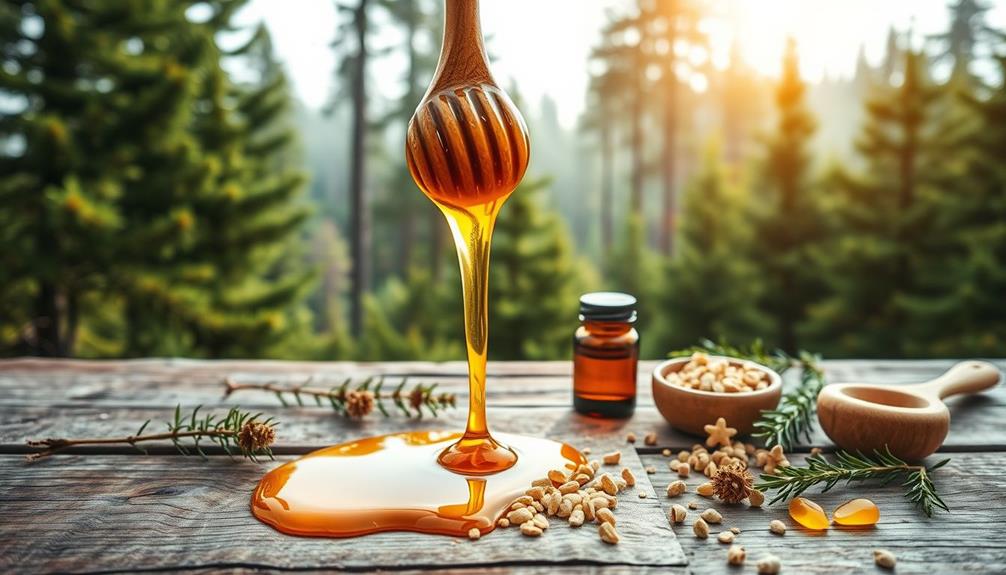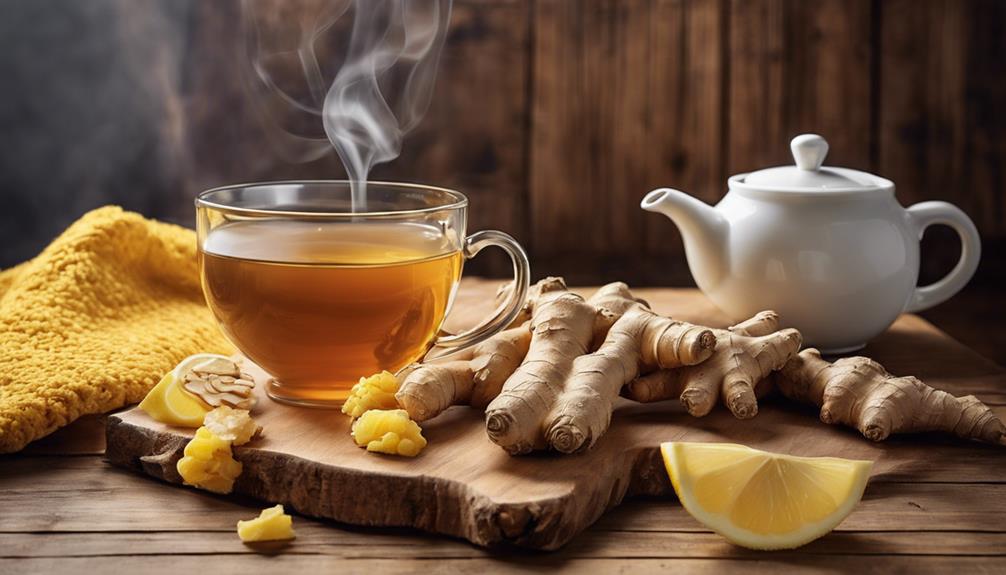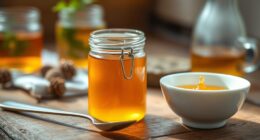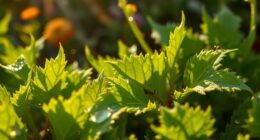Spruce honey, derived from honeydew on spruce trees, offers various traditional and modern medical applications. You can use it to soothe throat irritations and coughs, thanks to its antimicrobial properties. Rich in vitamins and minerals, it may also help with digestion and support immune health. Modern research points to its potential in wound healing and skin care. However, be cautious if you're over 60, pregnant, or diabetic, as it can have side effects. If you want to explore its culinary uses and preparation tips, there's much more you can discover about this remarkable honey.
Key Takeaways
- Spruce honey is traditionally used for its antimicrobial properties, soothing throat irritations and coughs.
- It contains antioxidants that may support overall health and reduce inflammation, aiding respiratory issues.
- Modern studies suggest spruce honey may have applications in wound healing and skin care.
- Caution is advised for certain groups, including individuals over 60, pregnant women, and those with diabetes.
- Sustainable harvesting practices promote tree health and ensure the availability of spruce tips for future use.
Formation of Spruce Honey
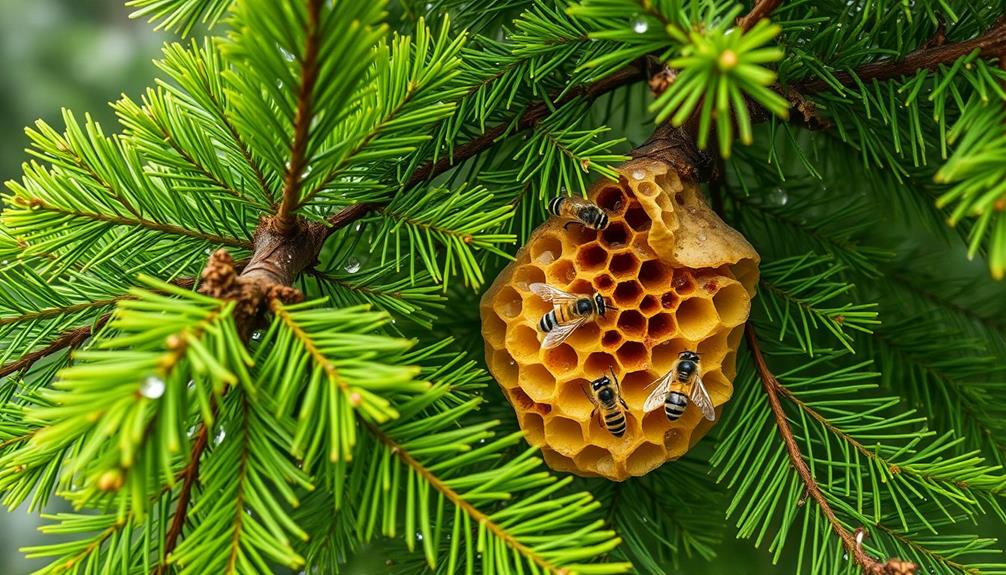
Spruce honey, unlike typical floral honey, forms through a fascinating process where bees collect honeydew excreted by aphids feeding on the sap of spruce and fir trees. This unique source sets spruce honey apart from other varieties, as these trees don't produce nectar. Instead, they depend on wind for pollination, leaving bees to turn to the sugary waste of aphids as their primary source.
Curiously, similar to how essential oils like clove oil are created from natural sources, the transformation of honeydew into spruce honey showcases nature's ability to produce beneficial substances from unconventional materials.
Once collected, the bees transform this honeydew within the hive, resulting in a dark, spicy forest honey that boasts distinct flavor profiles. The conversion process highlights the bees' remarkable ability to create a consumable product from a non-flowering source, showcasing their adaptability and resourcefulness.
Spruce honey's unique characteristics, including its rich color and robust flavor, stem from the specific environmental factors surrounding spruce and fir trees, as well as the diet of the bees involved.
This interplay between the trees and the bees ultimately produces a honey that stands out in both taste and texture. Understanding this formation process offers insight into the exceptional qualities of spruce honey, setting the stage for its potential medical applications.
Vegan Alternatives to Honey

If you're looking for a sweet alternative to honey, consider using spruce tips to create a delicious and nutritious syrup.
These tips not only offer rich Vitamin C benefits but are also packed with antioxidants, which can be beneficial for overall health nutritional benefits.
Additionally, they can enhance your favorite recipes while supporting sustainable harvesting practices.
Let's explore how you can incorporate this vegan option into your culinary creations.
Nutritional Benefits of Spruce Tips
While exploring vegan alternatives to honey, you'll find that fresh spruce tips offer a remarkable nutritional profile. These young shoots are packed with Vitamin C, containing about 28-32 mg per 100 grams, making them an excellent source of this essential nutrient that supports your immune system and overall health.
Additionally, incorporating such natural ingredients can enhance your creativity in the kitchen, leading to innovative culinary experiences enhances creativity.
You can easily incorporate spruce tips into your diet by consuming them raw in salads, where they add a unique flavor and a nutritional boost thanks to their high essential oil content. If you're feeling creative, consider using spruce tips in culinary applications like pesto or flavored salts, providing a nutritious twist to your favorite recipes.
Moreover, if you're looking for a sweet alternative, you can make a delicious vegan syrup by combining spruce tips with sugar and water. This syrup not only tastes great but also retains the nutritional benefits of the spruce tips.
Lastly, remember that sustainable harvesting is key. By taking minimal quantities from each tree, you promote continued growth and ecological balance, ensuring that these nutritional powerhouses remain available for generations to come.
Recipes Using Spruce Honey
When it comes to incorporating spruce honey into your culinary repertoire, the possibilities are both delicious and diverse. This unique honey, with its spicy flavor profile, can elevate your dishes in exciting ways.
But if you're looking for vegan alternatives, consider making spruce tip honey by simmering fresh spruce tips with sugar and lemon until syrupy. Here are three tasty ideas to use spruce honey or its vegan counterpart:
- Flavored Syrup for Pancakes: Drizzle spruce honey over your pancakes or waffles for an unexpected twist. You can also mix it with maple syrup for a delightful blend.
- Salad Dressings: Whisk spruce honey into vinaigrettes to add depth and a hint of sweetness to your salads. It pairs beautifully with mustard and olive oil.
- Spruce Tip Pesto: Blend fresh spruce tips with nuts, garlic, and olive oil for a vibrant pesto. Use this as a spread or toss it with pasta for a fresh meal.
Homemade spruce honey can be stored in sterile jars and used as a natural sweetener in teas, baking, and various dishes, enhancing both taste and nutrition.
Enjoy experimenting with these recipes!
Sustainable Harvesting Practices
Sustainable harvesting practices for spruce tips not only provide a vegan alternative to traditional honey but also promote ecological balance. By simmering fresh spruce tips with sugar and water, you can create a delicious, eco-friendly spruce honey. When harvesting, focus on young spruce tips, steering clear of older, darker needles to guarantee the tree continues to thrive.
To maintain the health of both the tree and surrounding ecosystem, it's essential to harvest minimally. This practice helps sustain growth and minimizes damage, allowing you to enjoy the benefits without compromising nature. Spruce tips are packed with Vitamin C and essential oils, adding nutritional value to your vegan honey.
Engaging in spruce tip harvesting can also be a fun and educational experience for children, teaching them about nature and sustainability.
Here's a quick overview of sustainable harvesting practices:
| Harvesting Practice | Benefits |
|---|---|
| Focus on young tips | Promotes tree health |
| Minimal harvesting | Protects ecosystem stability |
| Educating children | Fosters appreciation for nature |
| Rich in nutrients | Adds health benefits to diet |
Incorporate these practices into your routine for a sustainable lifestyle!
Identifying Safe Conifers

When you're foraging for spruce tips, it's essential to identify safe conifers to avoid any toxic varieties.
Remember, the yew tree is the only toxic conifer in the region, easily recognized by its soft, flat needles.
Use the mnemonic "Spruce pricks, fir does not" to help you distinguish spruce from fir, ensuring you harvest the right needles for your needs.
Safe Conifer Identification Tips
Identifying safe conifers can be straightforward with a few key tips in mind. Here are three essential points to keep you on track:
- Needle Characteristics: Remember the mnemonic "Spruce pricks, fir does not." Spruce needles are sharp and grow on small stems. In contrast, fir needles are rounded and attach directly to the branch.
- Young vs. Old Spruce: Young spruce shoots are safe to consume. Look for vibrant green color and tender texture. Avoid older, dark needles, as they may not be safe.
- Growth Pattern: Observe how the needles grow. Spruce needles cluster on small stems, while fir needles grow directly from the branch without clustering.
Additionally, be aware that yew trees are the only toxic conifers in the region, identifiable by their soft, flat needles that grow on both sides of the branch.
When harvesting spruce tips, do so minimally from each tree. This practice promotes sustainable growth and reduces the risk of contamination from nearby industrial areas.
Toxic Conifer Characteristics
While many conifers are safe to forage, it is vital to recognize the characteristics of toxic varieties, particularly the yew tree. The yew's soft, flat needles grow on both sides of the branch, making it distinct yet potentially dangerous.
To help you identify safe conifers, remember this simple mnemonic: "Spruce pricks, fir does not." This hints at the differences between spruce and fir needles. Spruce needles are sharp and have a square cross-section, while fir needles are soft and rounded.
Here's a quick reference table to highlight these differences:
| Conifer Type | Needle Characteristics |
|---|---|
| Yew | Soft, flat needles, toxic |
| Spruce | Sharp, square cross-section |
| Fir | Soft, rounded, safe |
When foraging, always avoid yew and focus on collecting young spruce shoots, which are safe and nutritious. Understanding these physical characteristics is necessary for safe identification, as some conifers may look similar but vary greatly in toxicity. Stay vigilant and make sure your foraging experience is both enjoyable and safe!
Culinary Uses of Spruce Tips
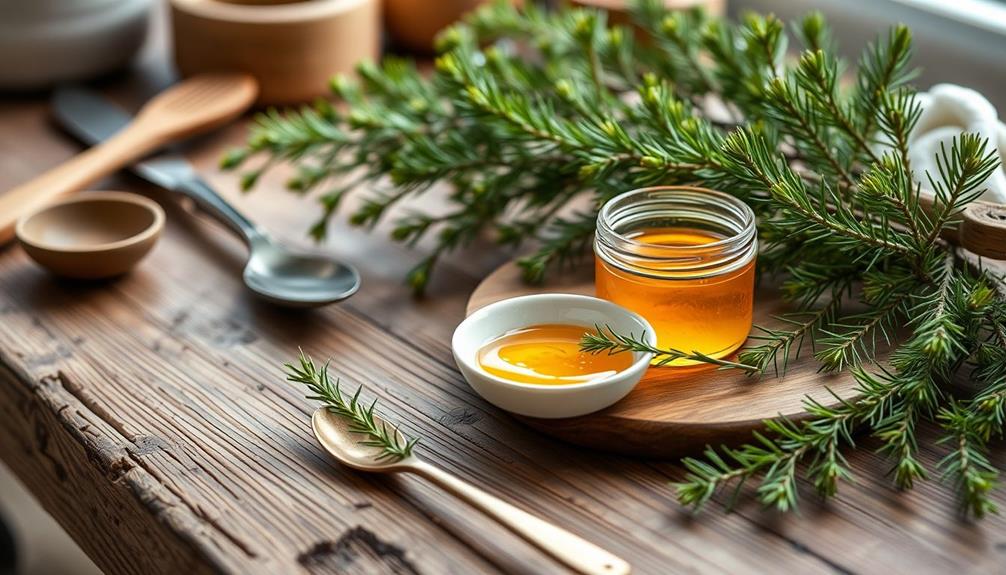
Spruce tips' vibrant, citrusy flavor makes them a delightful addition to a variety of dishes. You can easily incorporate these fresh tips into your culinary repertoire, bringing a unique twist to classic recipes. Here are three fantastic ways to enjoy spruce tips:
- Pesto: Blend spruce tips with basil, garlic, and olive oil to create a coniferous pesto that adds depth to pasta or sandwiches.
- Spruce Syrup: Make a homemade syrup from fresh spruce tips. Drizzle it over pancakes for breakfast or mix it into cocktails for a rejuvenating twist.
- Salads: Toss fresh spruce tips raw into your salads. Their high Vitamin C content and invigorating crunch can elevate your greens.
Additionally, you can craft flavored salts using spruce tips, enhancing meats and veggies with their aromatic qualities.
If you're feeling adventurous, consider making spruce honey for salad dressings, offering a sweet and tangy kick.
With their versatility, spruce tips can transform your dishes, making them not only flavorful but also packed with nutrients. Give these culinary uses a try, and you'll be amazed at how spruce tips can elevate your cooking!
Recipe for Spruce Tip Honey
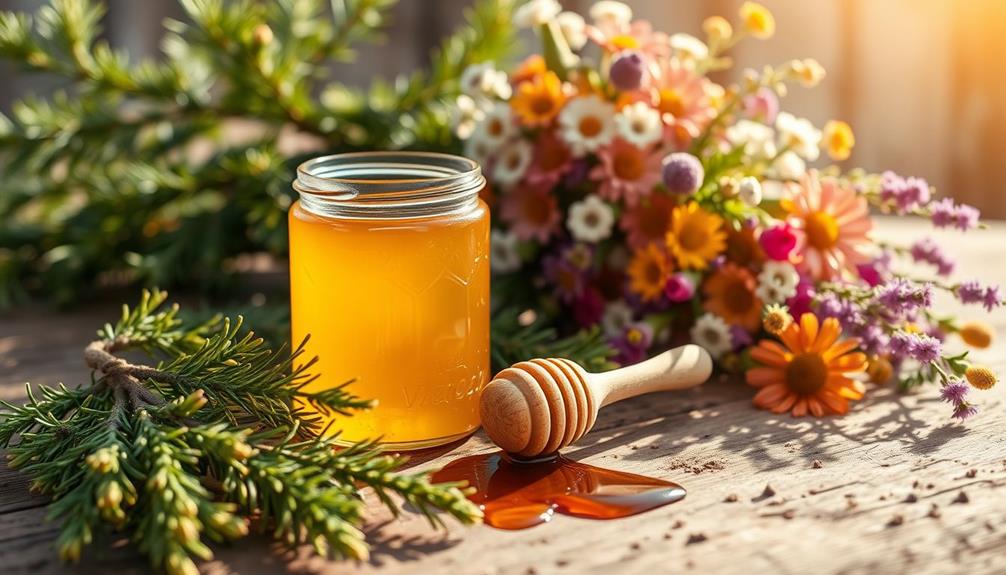
Making spruce tip honey is a rewarding endeavor that brings the vibrant essence of the forest right to your kitchen. To get started, gather 500g to 1kg of fresh spruce tips, 1kg of sugar, water, and one organic lemon for flavoring.
First, clean the spruce tips thoroughly. Next, simmer them in water for about 30 minutes to extract their wonderful flavors. After simmering, strain the mixture to separate the liquid from the tips.
Combine the strained liquid with the sugar and the juice of the organic lemon in a pot. Cook this mixture until it reaches a syrupy consistency, which should take around 30 minutes.
Once you've achieved that desired thickness, it's time to fill sterile jars with your finished spruce honey. This flavorful syrup can be used in various culinary applications, from drizzling over desserts to mixing into drinks.
Storing it in a cool, dark place will help preserve its deliciousness. Enjoy the fruits of your labor as you share this unique treat with family and friends!
Health Benefits of Spruce Honey
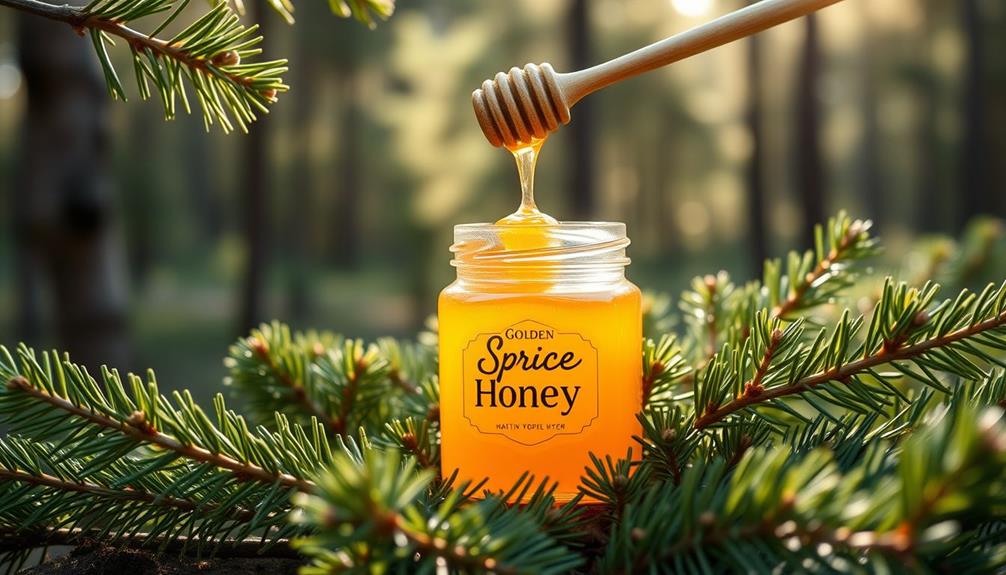
The health benefits of spruce honey are impressive, making it a valuable addition to your wellness routine. This natural remedy offers various therapeutic effects that can enhance your overall health. Here are three key benefits you can enjoy:
- Antimicrobial Properties: Spruce honey is known for its ability to combat upper respiratory diseases and soothe throat irritations, helping you breathe easier.
- Cardiovascular Support: With a high concentration of flavonoids, spruce honey aids in lipid normalization and cholesterol management, promoting better heart health.
- Immune System Boost: Rich in vitamin C, regular consumption can strengthen your immune system and help prevent iron deficiency anemia.
However, it's important to remember that spruce honey may not be suitable for everyone.
Individuals over 60, pregnant women, and those with diabetes or chronic kidney/liver diseases should avoid it due to its potent effects.
Incorporating spruce honey into your diet can offer numerous health benefits, but be mindful of your specific health conditions to ascertain it's a safe choice for you.
Chemical Composition Analysis
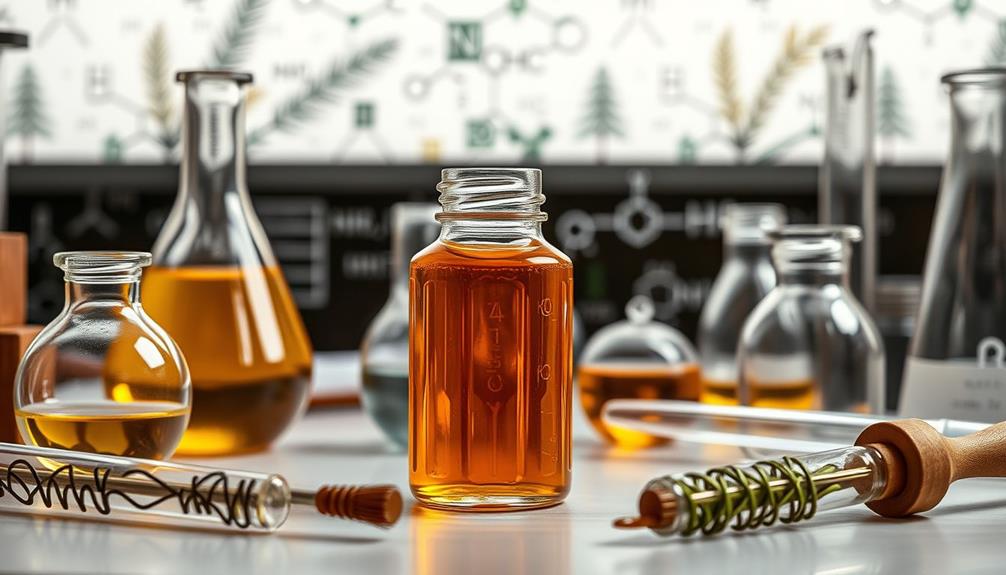
Understanding the chemical composition of spruce honey reveals why it's so beneficial for health. This honey is packed with essential micro- and macro-elements, including iron (0.9 mg), calcium (4 mg), and magnesium (4 mg) per 100 grams. These minerals play crucial roles in various bodily functions, supporting your overall well-being.
Moreover, spruce honey contains a rich array of vitamins, such as ascorbic acid (28-32 mg) and vitamin B6 (0.29-0.33 mg) per 100 grams, enhancing its health-promoting properties. The absence of proteins and pollen in its concentrated chemical makeup makes it particularly suitable for medical applications, ensuring fewer allergens.
Another critical aspect is the high concentration of flavonoids, which contribute to normalizing lipids and cholesterol levels, making spruce honey advantageous for heart health.
To verify the quality of spruce honey, you can perform tests using a slaked lime mixture, which checks for authenticity by forming flakes when heated. This analysis underscores the honey's unique characteristics and its potential as a natural remedy, solidifying its status in both traditional and modern medicine.
Contraindications and Precautions

Certain precautions are essential when considering the use of spruce honey, especially for specific groups of individuals. If you fall into any of the following categories, you should be particularly cautious:
- Individuals over 60: You may be more susceptible to side effects and should consult a healthcare professional before using spruce honey.
- Pregnant women: Since there's insufficient research on its effects on unborn children, it's best to avoid using spruce honey during pregnancy.
- People with diabetes: The high sugar content in spruce honey can elevate your blood sugar levels, making it advisable to steer clear of this honey.
Additionally, if you have chronic kidney or liver conditions, be careful as the diuretic properties of the honey could increase the strain on these organs.
Finally, if you're allergic to tree resins or bee products, you should be aware that spruce honey can trigger allergic reactions.
Always consult with a healthcare provider before adding new products to your regimen, especially if you have any underlying health concerns. Your well-being should always come first!
Other Conifer Honey Varieties
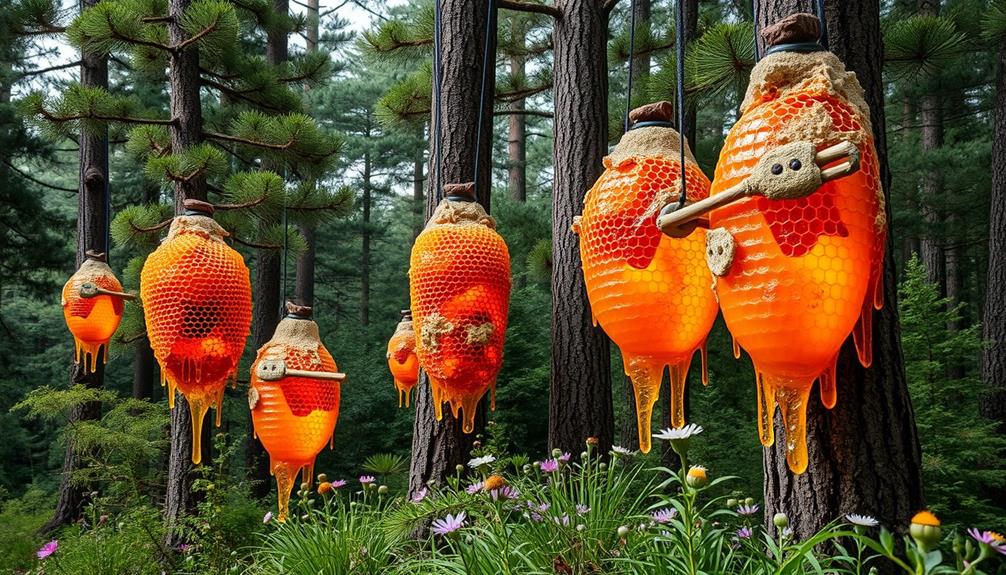
You might be surprised to discover that conifer honey varieties are as diverse as the trees they come from.
Spruce honey, for instance, boasts a dark green or brown hue, delivering a spicy-sour taste and a distinct forest aroma that sets it apart from other honey types. If you enjoy a more tart flavor, you might find fir honey appealing. It's noted for its pronounced sour aroma and is less sweet than traditional flower nectar, offering a unique tasting experience.
Then there's tannen honey, which varies in color and saturation based on the tree species. Each variety provides a distinct taste profile, enriching your palate with new flavors.
These conifer honey types, which include spruce, fir, and tannen, are considered rare due to the challenges associated with collecting them from trees. Unlike propolis honey, which comes from bee resin, or flower nectar honey, conifer honey comes from tree secretions, placing it in a unique category within the honey spectrum.
Exploring these different varieties can enhance your appreciation for the complexity of honey and its various health benefits.
Harvesting and Preparation Tips
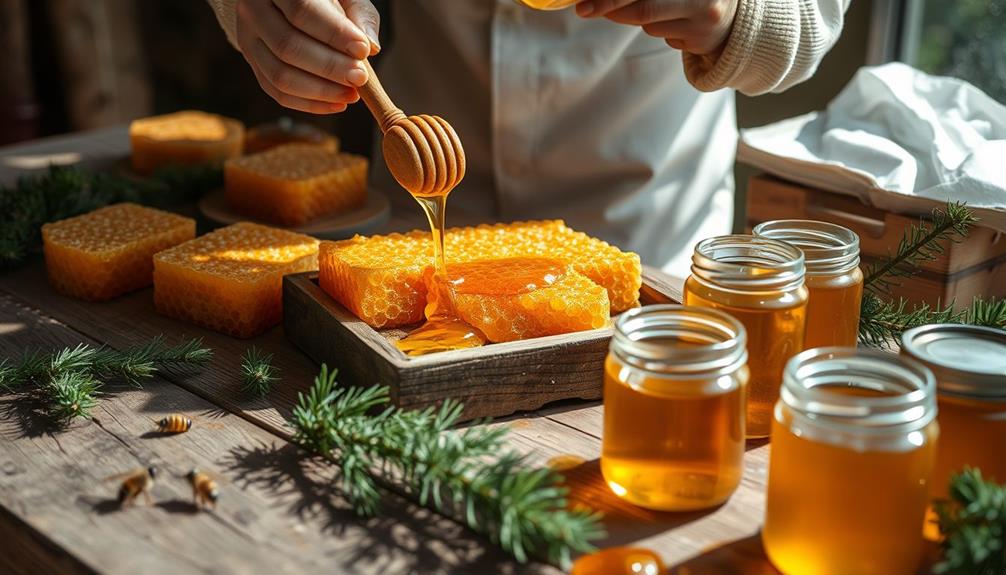
Exploring the unique flavors of conifer honey varieties like spruce sets the stage for learning how to harvest and prepare them effectively. To guarantee you get the best flavor and health benefits, follow these tips:
1. Harvest Timing and Technique: Collect fresh spruce tips in late April to early May. Focus on soft green shoots and avoid older needles to minimize impact on the tree's growth.
Always harvest away from roads and industrial areas to prevent pollution exposure.
2. Preparation of Spruce Tips: Clean the spruce tips thoroughly to remove any debris.
Simmer them in water to extract their flavors effectively. This step is vital for creating a rich infusion.
3. Creating Spruce Honey: Combine the strained spruce tip infusion with sugar and organic lemon.
Cook the mixture until it reaches a syrupy consistency, yielding a delightful spruce honey.
Once ready, use sterile jars for bottling to guarantee preservation and prevent contamination.
Frequently Asked Questions
What Is Spruce Honey Good For?
Spruce honey's great for boosting your immune system, supporting respiratory health, and managing cholesterol levels. It can help prevent iron deficiency anemia and aid urinary health, making it a beneficial addition to your diet.
What Is Fichte Suitable For?
Imagine you're a medieval herbalist. Fichte's great for improving respiratory health, boosting immunity, and aiding digestion. Its unique properties support a healthy cholesterol level, making it a versatile choice for your wellness toolkit.
How Healthy Are Spruce Tips?
Spruce tips are incredibly healthy for you! They're packed with Vitamin C, essential oils, and antioxidants, supporting your immune system, respiratory function, and skin health. Try incorporating them into your meals for added nutritional benefits!
Conclusion
To summarize, spruce honey isn't just a sweet treat; it's a treasure trove of health benefits rooted in both tradition and modern science. By exploring its formation, culinary uses, and chemical composition, you'll find it's a versatile ingredient worth incorporating into your diet. Just remember to be mindful of contraindications and safe sourcing. So, whether you're drizzling it over your breakfast or using it in remedies, spruce honey can truly be a golden addition to your wellness journey.
